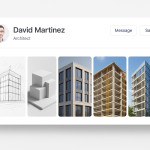Architect bio that ranks: keywords attracting property developers
Want property developers to shortlist you before they scroll to the next architect profile? It starts with a bio engineered for both humans and search engines. Follow this step-by-step guide to sprinkle the right keywords, showcase commercial value and convert directory views into project calls.
Why a keyword-rich architect bio is your silent sales rep
Property developers search online at late hours, comparing dozens of architects in minutes. Your online bio becomes a 24/7 pitch deck. By weaving developer-specific keywords such as “mixed-use feasibility study” or “build-to-rent planning consent” into clear benefit-led sentences, you surface earlier in directory results and communicate instant relevance.
Keyword research fundamentals: think like a developer

Look at that screen: export sheets crammed with search volumes, competitive gaps and developer-centric phrases cascading alongside zoning maps and massing studies. When you picture the process visually, it becomes easier to remember that keyword research is not a sterile spreadsheet chore but a strategic design exercise. By aligning the language of yield targets, GDV projections and planning jargon with the emotional promise of smooth approvals, you start speaking fluent developer long before a single line is drawn. Imagine every highlighted cell as a future paid invoice—suddenly the motivation to refine terms like “brownfield cost appraisal architect” skyrockets.
Map the property lifecycle vocabulary
- Site acquisition: “yield analysis”, “plot ratio”, “land survey drawings”.
- Design phase: “value engineering”, “floor-plate efficiency”, “BIM clash detection”.
- Planning & compliance: “Section 106 negotiation”, “BREEAM Very Good”, “fire strategy report”.
- Marketing & exit: “CGI marketing pack”, “virtual walkthrough”, “investor pitch visuals”.
Unearth long-tail gems
Long-tail phrases (4+ words) face lower competition yet reveal strong intent. Examples developers actually type:
- “Architect for co-living conversion London”
- “Architect passive-house apartments under €3 million”
- “Architect heritage façade retention advice”
Place two or three of these phrases naturally in your bio to capture niche briefs faster than generic “architect London”.
Craft a headline that hooks and ranks
Most directories give you 80-120 characters for a headline. Combine an outcome keyword + unique strength + proof element:
“Unlock 12% ROI on urban infill sites – RIBA architect | 30 000 m² built, 98% planning success”
Outcome keyword (“urban infill sites”) speaks to the developer's end goal and boosts search relevance.
Optimise every bio section for property-developer intent
Opening sentence: promise commercial impact
Start with a concise value proposition: “I help developers add rentable floor area without inflating build cost.” You immediately align with profit-focused objectives.
Signature projects: numbers beat adjectives
Swap “large residential scheme” for “176-unit PRS tower, £42M GDV, delivered 8 weeks ahead of programme.” Quantifiable data builds trust.
Accreditations & trust badges
Mention “ARB, RIBA Chartered”, but also developer-centric proofs like “ISO 19650 BIM assessor” or “NHBC warranty compliant detailing”. For an extra visibility boost, display recognised accreditation badges recruiters filter by.
Materials & sustainability tags
Developers increasingly search for “embodied-carbon architect” or “timber-frame high-rise”. List specific low-carbon credentials and link to case studies where possible.
Project-phase snapshots
Visuals indexed by phase (“concept massing”, “technical package”, “completion shots”) keep you memorable and feed search algorithms. Learn how to arrange them in this dedicated tutorial.
On-page SEO checklist for directory bios
| Element | Action | Reason |
|---|---|---|
| Headline | Include 1 primary keyword | Boosts click-through & ranking |
| First 155 characters | Add long-tail variant | Often used as meta description |
| Image filenames & alt | “modular-housing-architect-london.jpg” | Improves image search visibility |
| Bullet lists | Highlight ROI stats & awards | Enhances skim-readability |
| Internal links | Reference related guides | Signals topical authority |
Directory algorithm boosters you can apply today

Translating those insights into directory algorithm love means feeding the machine precise, well-structured data. Picture a dashboard where each colour badge ticks a new ranking factor: green for BIM Level 2, blue for mixed-use expertise, orange for freshly uploaded feasibility sketches. When you treat your profile as living software rather than a static CV, you naturally schedule content sprints—adding borough clusters on Monday, linking an award article on Wednesday, renaming imagery on Friday. This workflow sends recurring freshness pings and relevance signals that lift you above dormant competitors, ensuring decision-makers keep encountering your name at exactly the right moment.
- Metadata tags – Match developer filters (“BIM Level 2”, “Mixed-use”, “Up to 20 storeys”). Deep dive in this metadata playbook.
- Geo-targeting – Add borough or postcode clusters instead of one city to hit local land searches.
- Freshness signals – Upload a recent feasibility sketch monthly; directories reward active profiles.
- External authority link – Reference your listing on the Artfolio spatial designers directory to reinforce credibility.
Common pitfalls that tank rankings
- Stuffing “architect” 20 times – triggers spam filters and bores readers.
- Using residential-buyer language (“cosy”, “bespoke kitchen”) – developers care about yield, not cushion counts.
- Listing every service ever offered – dilute keyword focus. Prioritise three revenue-driving niches.
30-minute quick-win roadmap
- Paste your current bio into a word cloud tool. Remove words that don't matter to developers (e.g., “passionate”, “creative”).
- Add two long-tail phrases uncovered earlier.
- Rename top three project images with keyword-rich filenames and alt text.
- Create one internal link to a filter-optimisation guide.
- Update headline with a measurable result (%, weeks saved, £).
Quiz: Are you speaking developer language?
FAQ
- How long should my architect bio be?
- Aim for 150–250 words. Concise enough to skim, rich enough for keywords and proof points.
- Can I target multiple developer niches in one bio?
- Yes, but cluster them: “Co-living | PRS towers | Adaptive reuse”. Three is the sweet spot before relevance drops.
- Do awards still influence search ranking?
- Indirectly. Awards earn backlinks and brand mentions that boost authority signals, helping your bio rank higher.
- How often should I update keywords?
- Quarterly. Track emerging terms like “15-minute city architect” and weave them in if they align with your services.
Key takeaways
- Use developer phrases, not generic design jargon.
- Lead with measurable commercial outcomes.
- Refresh images, filenames and metadata to keep algorithm love strong.
Ready to turn profile views into lucrative site visits? Update your architect bio today and watch property developers slide into your inbox.











